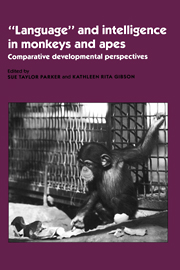Book contents
- Frontmatter
- Contents
- List of contributors
- Foreword
- Preface
- Acknowledgments
- Part I Theoretical frameworks for comparative developmental studies
- Part II Comparative developmental perspectives on cebus intelligence
- Part III Questions regarding imitation, “language,” and cultural transmission in apes and monkeys
- Part IV Developmental perspectives on social intelligence and communication in great apes
- 12 The emergence of intentional communication as a problem-solving strategy in the gorilla
- 13 “Social tool use” by free-ranging orangutans: A Piagetian and developmental perspective on the manipulation of an animate object
- 14 The development of peer social interaction in infant chimpanzees: Comparative social, Piagetian, and brain perspectives
- 15 Spatial expression of social relationships among captive Pan paniscus: Ontogenetic and phylogenetic implications
- Part V Development of numerical and classificatory abilities in chimpanzees and other vertebrates
- Part VI Comparative developmental perspectives on ape “language”
- Index
14 - The development of peer social interaction in infant chimpanzees: Comparative social, Piagetian, and brain perspectives
Published online by Cambridge University Press: 11 May 2010
- Frontmatter
- Contents
- List of contributors
- Foreword
- Preface
- Acknowledgments
- Part I Theoretical frameworks for comparative developmental studies
- Part II Comparative developmental perspectives on cebus intelligence
- Part III Questions regarding imitation, “language,” and cultural transmission in apes and monkeys
- Part IV Developmental perspectives on social intelligence and communication in great apes
- 12 The emergence of intentional communication as a problem-solving strategy in the gorilla
- 13 “Social tool use” by free-ranging orangutans: A Piagetian and developmental perspective on the manipulation of an animate object
- 14 The development of peer social interaction in infant chimpanzees: Comparative social, Piagetian, and brain perspectives
- 15 Spatial expression of social relationships among captive Pan paniscus: Ontogenetic and phylogenetic implications
- Part V Development of numerical and classificatory abilities in chimpanzees and other vertebrates
- Part VI Comparative developmental perspectives on ape “language”
- Index
Summary
Introduction
Following Harlow's work (e.g., Harlow & Harlow, 1965), numerous studies have confirmed the fundamental importance of the peer affectional system in the social development of humans and nonhuman primates (e.g., Mason, 1963; Lewis & Rosenblum, 1975). Peer-oriented activities predominate during youth in most social primate species, including humans, and the formation of stable peer relationships early in life appears essential to the development of normal adult social behavior (Argyle, 1969; Harlow & Harlow, 1965; Lewis & Rosenblum, 1975; Loizos, 1967; Mason, 1963; Suomi & Harlow, 1975; van Lawick-Goodall, 1968). As a result of extensive research since the 1970s, we now recognize that peer contact can affect social development even during infancy. Distinctly structured peer relationships of considerable complexity can begin to develop as early as 1–2 months of age in both human and nonhuman primates. In hand-reared nonhuman primates, infant peer contact is able to offset loss of the mother (Fritz, 1984).
Although by now the published literature on early peer social development is substantial, it is deficient in two aspects that have guided the design of the current project. First, prior research on infant peer social development had focused either on humans or on a narrow range of monkey species, primarily rhesus macaques. I found anecdotal evidence but no published systematic studies on infant peer social development in the great apes. This is a serious deficit, as the great apes are the closest living genealogical relatives to humans.
Information
- Type
- Chapter
- Information
- 'Language' and Intelligence in Monkeys and ApesComparative Developmental Perspectives, pp. 379 - 419Publisher: Cambridge University PressPrint publication year: 1990
Accessibility standard: Unknown
Why this information is here
This section outlines the accessibility features of this content - including support for screen readers, full keyboard navigation and high-contrast display options. This may not be relevant for you.Accessibility Information
- 1
- Cited by
